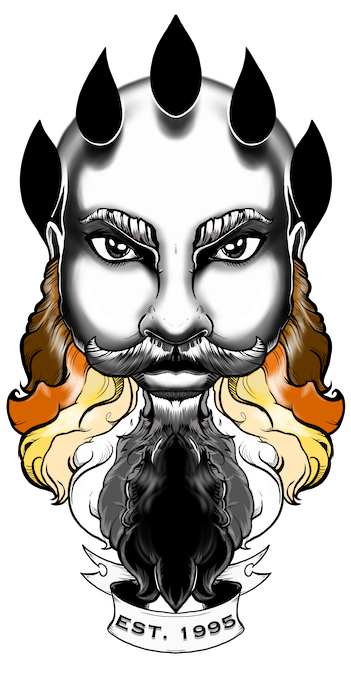
OPINION: 25 Years of Bear Stripes: Why Inclusion Matters in the Bear Community
Two years ago, the Bear community was in a bit of an uproar when attention was called to the member request form of a certain Facebook Bear community group.
A statement had apparently been added after many of the members had already joined the group, causing outrage to people who were not privy of the blatant racism in the text. The statement read: “If you are Asian or African do not join the group because it will be blocked from this group.”
The incident sparked an important conversation, not just in the Facebook group or Bear community, but in the gay community at large. Conversations about racist and discriminatory sexual preferences, and the overall bigotry and exclusion present in the community opened up even more.
Conversations about racism were already taking place following the debut of the 2017 Philadelphia Pride flag, which added black and brown stripes to its rainbow pattern. These stripes were meant to represent the inclusion of black and brown people, or people of color, in the LGBTQ+ community.
For many people of color, discrimination and exclusion in the LGBTQ+ community is a stark reality — one that feels particularly offensive, given the fact that the Stonewall riots of 1968 — which was the impetus for LGBTQ+ rights movement — were led by Marsha P. Johnson, a Black trans woman, and Sylvia Rivera, a Latinx trans woman. How can a community whose entire movement was given life because of someone like you also hate you?
And it feels even more offensive to be discriminated against in a community like the Bear community, which was basically created in order to provide space for the husky, rugged types who felt out of place in the general gay population that seemed to favor hairless pin-up boys with ripped abs as opposed to large, hairy men with big bellies, love handles and dad bods. The community was created as a result of the lack of diversity in the broader gay community.
The Flag
The Bear Flag, or more properly, The International Bear Brotherhood Flag, was created in 1995. The seven horizontal colors — Dark brown, orange/rust, golden yellow, tan, white, gray, and black — were originally designed to represent actual bear fur colors around the world, though these colors have sometimes been interpreted as a representation of the skin and hair colors of the men in the Bear community.
Regardless of what the colors were specifically intended to represent, the fact of the matter is that the multiple colors were always meant as a symbol of diversity and inclusion; Bears come in all different shades and colors.

The flag was created just three years after the announcement of the Rodney King trial verdict on April 29, 1992, in which a jury in the Los Angeles suburb of Simi Valley acquitted four White police officers who had been charged with brutally beating Rodney King, a 25-year-old Black man, during a traffic stop a year earlier. The announcement of the verdict enraged the Black community, prompting the L.A. riots, which lasted for three days.
Protests
Throughout the years, it seems that these crimes have become more and more prevalent, and becoming more and more fatal. The list of names of Black men and women murdered in racially motivated hate crimes, mostly at the hands of American law enforcement, have sparked similar outrage.
And this year, it seems that even a global pandemic couldn’t stop the violence against Black bodies in America, with the murders of Ahmaud Arbery, Breonna Taylor and George Floyd all happening in the span of three months when much of the country was quarantined and practicing social distancing.
After the murder of George Floyd last month, the Black community has once again become enraged. The protests and riots draw comparison to many of the ones that have come before it, due to the brutal murders of Black people in America — the 2015 Baltimore protests after the murder of Freddy Gray; the 2014 Ferguson protests after the death Michael Brown; the 1992 protests after the brutal beating of Rodney King; and the 1968 riots after the death of Dr. Martin Luther King, Jr.
Hopefully, America is realizing that history still seems to be repeating itself over 50 years after the murder of Dr. King. And after over 400 years of racial injustice, it’s not too shady to wonder if America will ever learn its lesson.
And, though racial tension between Black people and White people in America has been going on for centuries, White bigotry doesn’t just stop there. For the last four years, under the Trump administration, the blatant racism of America has been on full display.
From the complete violent disregard for Native American protestors at Standing Rock, to the enacting of violent and inhumane immigration laws that mostly criminalize Mexican and Latinx Americans, to the banning of Iranian and Muslim nationals and imposing travel bans to those countries, to Donald Trump openly referring to the new coronavirus as the “Chinese Virus” — racism and bigoted ideology seems to be just as potent as ever.
However, even with these overt and unapologetically callous instances of discrimination and violence in America, racial “preferences” — many of which are rooted in problematic and toxic social conditioning — are still condoned and supported in many spaces in the gay community.
Harmful Preferences
Somehow, even with black, brown, yellow, tan and gray stripes added to our pride flags, we sometimes still support the writing of “No Blacks, no Asians, no fats, no fems” on dating app profiles, because… These are just preferences, right?
We can have a very long and needed discussion about preferences, including how and why some preferences are more harmful than others, and at which point does it go from being a sexual preference to discrimination, but this isn’t neccesarily the point of this particular article. Also, this article isn’t meant to just rip into the LGBTQ community as if there have been absolutely no advances in how we think and treat one another. Some things have definitely changed.
However, with so much racism and bigotry still happening throughout the world, and so many instances of toxic and racist behavior in every facet of the LGBTQ community, it is clear that, now more than ever, we need to think about what work still needs to be done.
Maybe Pride festivals around the world being cancelled this year is the universe’s way of telling us that we need to take the time this year to examine racial injustice in the LGBTQ community, and what we can do to ignite real change.
After 25 years in existence, the Bear flag has been a symbol of diversity and inclusion, which is fundamentally what our community was built on. It is the job of the community to continue to uphold these standards, and continue to challenge bigotry, discrimination and systemic racism, not just in our community, but in the world. Anything else would go against what we stand for.











